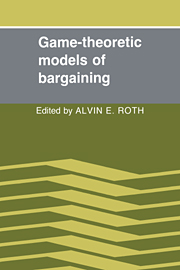Book contents
- Frontmatter
- Contents
- List of contributors
- Preface
- Chapter 1 Editor's introduction and overview
- Chapter 2 Disagreement in bargaining: Models with incomplete information
- Chapter 3 Reputations in games and markets
- Chapter 4 An approach to some noncooperative game situations with special attention to bargaining
- Chapter 5 Infinite-horizon models of bargaining with one-sided incomplete information
- Chapter 6 Choice of conjectures in a bargaining game with incomplete information
- Chapter 7 Analysis of two bargaining problems with incomplete information
- Chapter 8 Sequential bargaining mechanisms
- Chapter 9 The role of risk aversion in a simple bargaining model
- Chapter 10 Risk sensitivity and related properties for bargaining solutions
- Chapter 11 Axiomatic theory of bargaining with a variable population: A survey of recent results
- Chapter 12 Toward a focal-point theory of bargaining
- Chapter 13 Bargaining and coalitions
- Chapter 14 Axiomatic approaches to coalitional bargaining
- Chapter 15 A comment on the Coase theorem
- Chapter 16 Disclosure of evidence and resolution of disputes: Who should bear the burden of proof?
- Chapter 17 The role of arbitration and the theory of incentives
Chapter 16 - Disclosure of evidence and resolution of disputes: Who should bear the burden of proof?
Published online by Cambridge University Press: 23 September 2009
- Frontmatter
- Contents
- List of contributors
- Preface
- Chapter 1 Editor's introduction and overview
- Chapter 2 Disagreement in bargaining: Models with incomplete information
- Chapter 3 Reputations in games and markets
- Chapter 4 An approach to some noncooperative game situations with special attention to bargaining
- Chapter 5 Infinite-horizon models of bargaining with one-sided incomplete information
- Chapter 6 Choice of conjectures in a bargaining game with incomplete information
- Chapter 7 Analysis of two bargaining problems with incomplete information
- Chapter 8 Sequential bargaining mechanisms
- Chapter 9 The role of risk aversion in a simple bargaining model
- Chapter 10 Risk sensitivity and related properties for bargaining solutions
- Chapter 11 Axiomatic theory of bargaining with a variable population: A survey of recent results
- Chapter 12 Toward a focal-point theory of bargaining
- Chapter 13 Bargaining and coalitions
- Chapter 14 Axiomatic approaches to coalitional bargaining
- Chapter 15 A comment on the Coase theorem
- Chapter 16 Disclosure of evidence and resolution of disputes: Who should bear the burden of proof?
- Chapter 17 The role of arbitration and the theory of incentives
Summary
Introduction
This chapter discusses the role of a third party in settling disputes. A judge is responsible for deciding which of two bargainers should win a dispute. There is a social value associated with giving the disputed item to a particular bargainer. This is the bargainer's claim to the item. Each bargainer knows the strength of his claim and can provide evidence that proves his claim to the judge. Presenting proof is costly and distortion is impossible. However, it is possible to refuse to present evidence. The judge has a prior distribution about the strength of the claims, but does not know them exactly. The judge uses the information provided by the bargainers' disclosures (or decision not to provide evidence) and then rules in favor of the bargainer who has the best expected claim. When the bargainers must decide whether to provide evidence simultaneously, there are typically two types of equilibria. In one, each bargainer has a positive probability of winning if he does not provide evidence. In the other, one of the bargainers wins only if he proves his claim. Thus, rules about which bargainer has the burden of proof, that is, who must provide evidence in order to win the dispute, serve to select an equilibrium outcome. This discussion compares the welfare obtainable from different rules. The results are ambiguous.
- Type
- Chapter
- Information
- Game-Theoretic Models of Bargaining , pp. 341 - 362Publisher: Cambridge University PressPrint publication year: 1985
- 22
- Cited by

